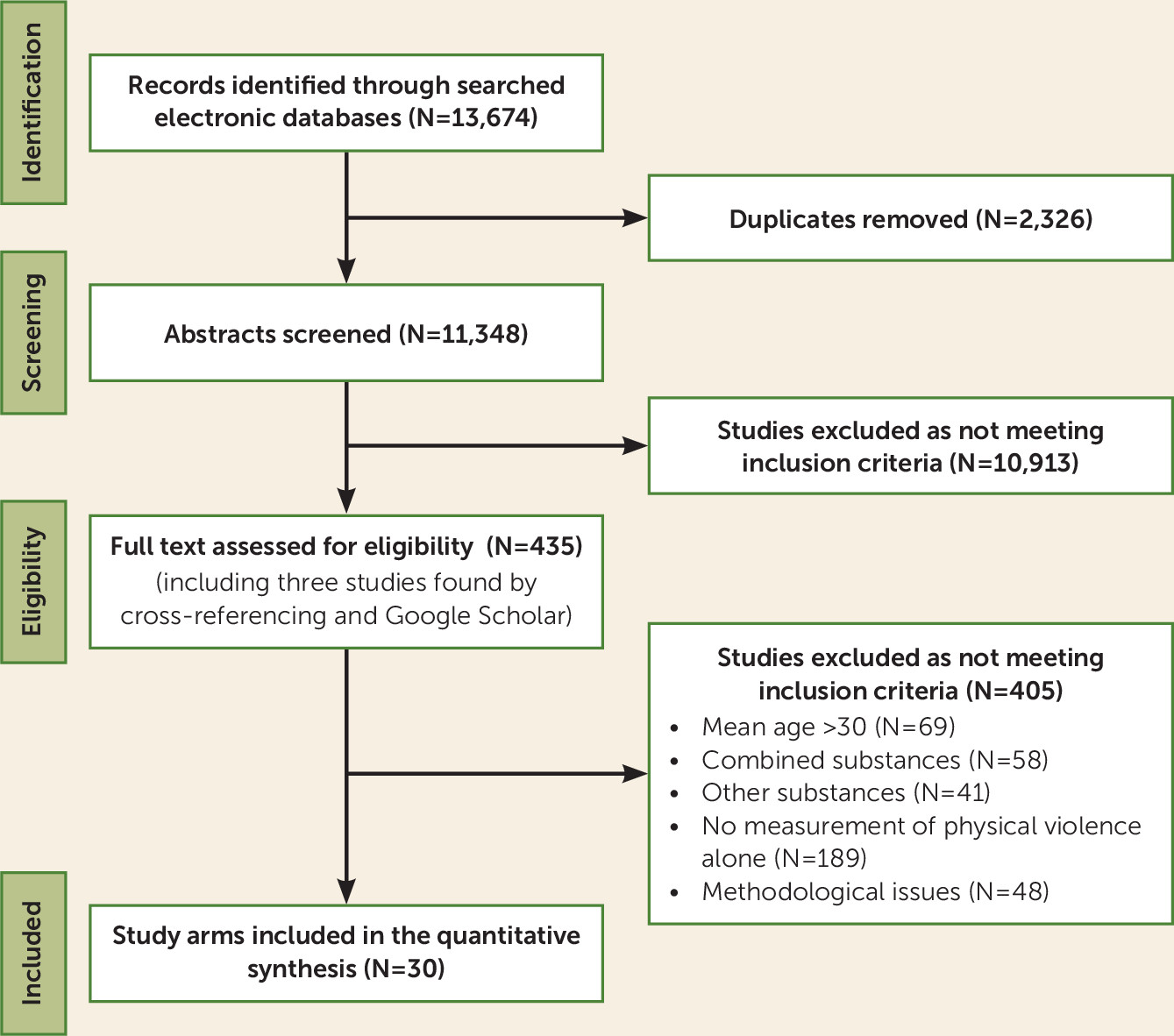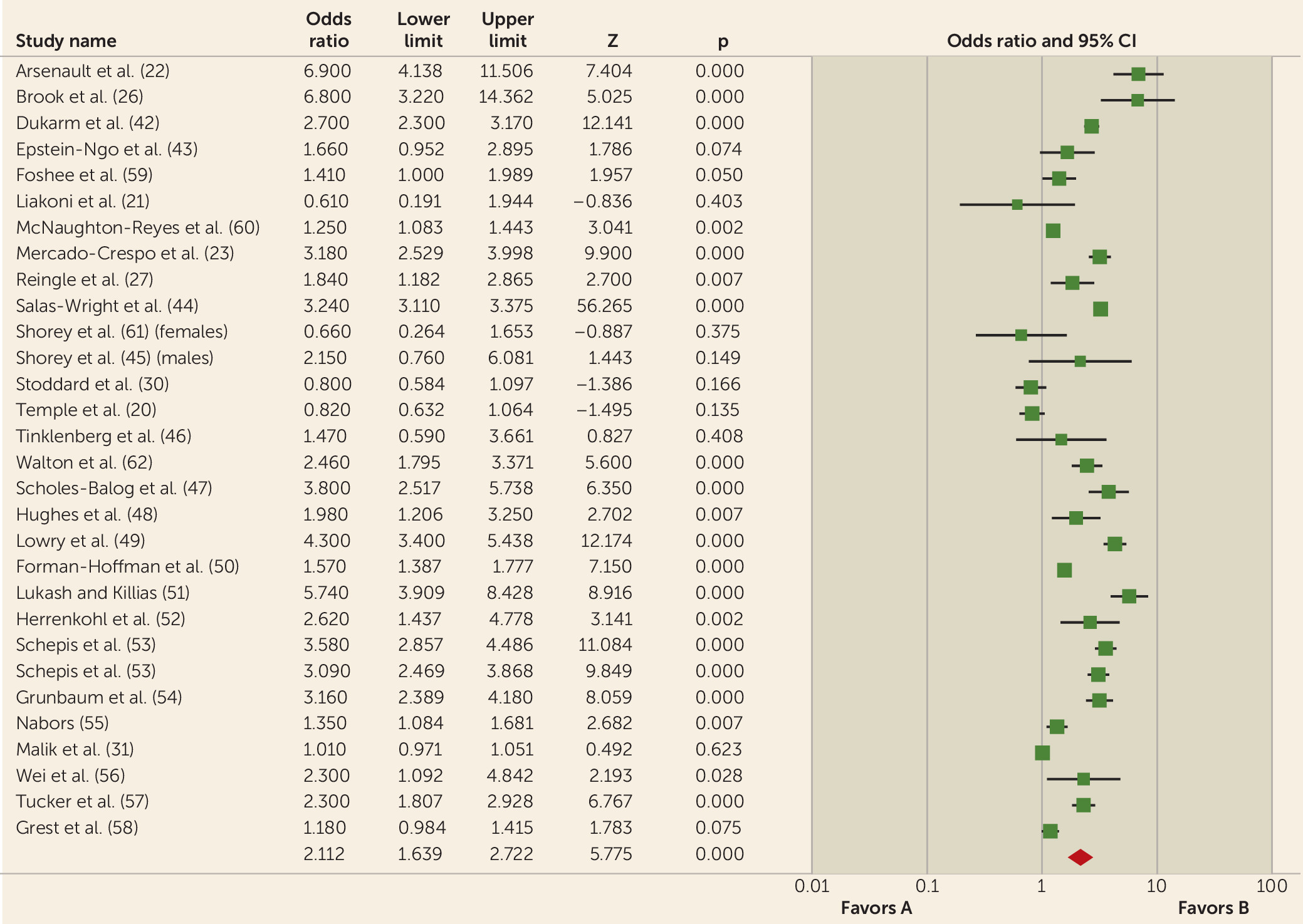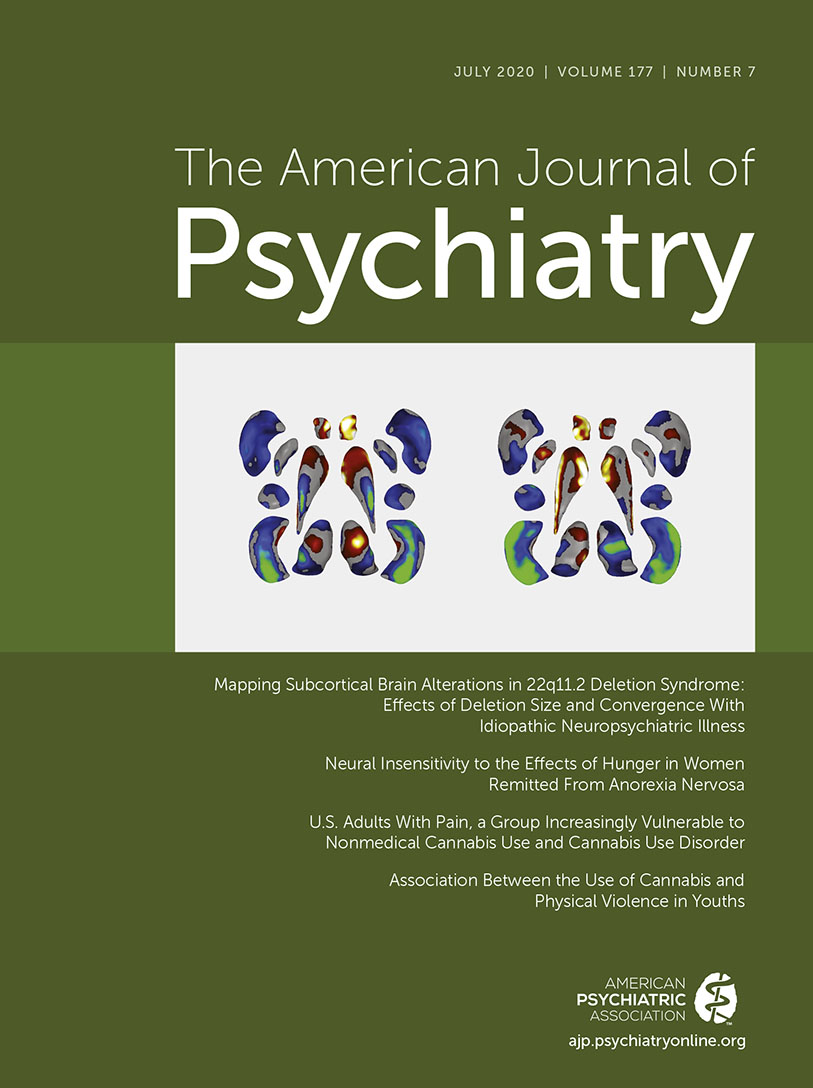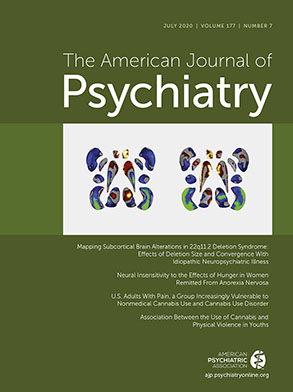Cannabis is the most commonly consumed illicit drug in several countries around the world, including the United States and the United Kingdom, and approximately 3.8% of the world’s population are recreational users (
1). In the past few decades, there has been a marked increase in the use of cannabis by young individuals in most developed societies, with occasional use becoming a more common experience (
1–
3). The use of cannabis typically commences before age 20, with onset peaking between ages 16 and 18 (
4). In 2017, 12.4% of adolescents over age 12 and 34.9% of young adults ages 18–25 consumed cannabis in the United States (
5). These high rates of cannabis use are a matter of concern, given evidence showing unfavorable cognitive, behavioral, and mental health issues attributed to cannabis use, mainly with frequent and heavy use, among youths (
6–
8). In fact, a range of adverse outcomes, such as poor social and academic functioning, cognitive impairment, and mental health problems such as psychosis, cannabis dependence, depression, and suicidality, have been shown to be significant among young people (
9–
15). In addition, these adverse effects often continue throughout the lifespan, leading to enduring physical and psychological difficulties, other substance misuse, and involvement with the criminal justice system (
16,
17).
Among the possible consequences of cannabis use for adolescents and young adults, the literature has shown that cannabis use may lead to violent behaviors and aggression; however, this association has been inconsistent in both cross-sectional and longitudinal studies (
18–
21). Several studies found a statistically significant association between cannabis use and violence in youths (
22–
25), and preliminary evidence suggests a dose-response relationship (
19,
26–
28). For example, in a systematic review and meta-analysis of dating violence among youths ages 11–21, Johnson et al. (
29) found that the odds of perpetration of violence were 45% higher among cannabis users compared with non-users (odds ratio=1.45, 95% CI=1.20, 1.76). Conversely, a negative association or no association at all was reported in other studies (
21,
30,
31). Additionally, some authors have questioned the directionality of the cannabis-violence association—whether the use of cannabis may lead to involvement in violence or vice versa—and a possible bidirectional relationship has been examined (
19,
32,
33). Different mechanisms by which the use of cannabis may be associated with violence have been put forth in the literature (e.g., symptoms related to intoxication and withdrawal or an interaction with a developmental predisposition for aggression [i.e., type of temperament, antisocial traits]) (
18). Hence, considering the limitations of recent studies, they leave a somewhat fragmented and unclear picture of the association between cannabis use and violence. For this reason, we chose to conduct a meta-analysis to further clarify the association between cannabis use and violence, and, more specifically, the perpetration of any type of physical violence by adolescents and young adults.
Discussion
Violence has severe health and social consequences, mostly in younger populations. According to the World Health Organization (
63), roughly 1.6 million deaths worldwide are attributed to violence, with 10–40 times as many physical injuries requiring medical attention. In this regard, the effects of cannabis on violence have sparked a variety of debates. Our meta-analytical investigation contributes to the body of research by elucidating the association of cannabis use with physical violence in adolescents and young adults. Based on a meta-analysis of 30 study arms, with a considerable sample of 296,815 participants, we found a moderate association between cannabis use and the perpetration of physical violence. The observed relationship remained unchanged regardless of study design and adjustments for confounding factors (i.e., socioeconomic factors, other substance use).
Violence is complex and multifactorial. Nevertheless, this study suggests that cannabis use appears to be a contributing factor in the perpetration of violence. Results of this meta-analysis indicate that cannabis use among youths is moderately associated with physical violence; this finding is derived from studies not only yielding a large sample size of adolescents and young adults but also showing no publication bias. Moreover, these results are consistent with those of a previous review (
29). With available data specifically from longitudinal studies included in our meta-analysis, our findings show that cannabis use may indeed lead to perpetration of physical violence later on among adolescents and young adults. Even when considering studies that additionally adjusted for several covariates, the effect remained significant. Although the effect is at best modest, it remains essential given the elevated proportion of youths who used cannabis, both occasionally and frequently (
5). Thus, the consumption of cannabis may have short- and long-term consequences, which should be considered in this context. Several potential mechanisms have been established to help explain the observed association. One explanation is that cannabis may affect users’ physiological and psychological states (i.e., it impairs the ability to tamp down aggressive impulses; induces feelings of paranoia, anxiety, and panic; and increases physiological arousal) (
18,
20). Particularly in dependent users, abstinence and withdrawal may contribute to irritability and lead to the likelihood of emotional outbursts (
18,
64). Another explanation relates to the interaction with interpersonal and contextual factors, which are rarely considered (
18). Therefore, the behavioral characteristics of cannabis users may include a higher tolerance for delinquency, more engagement in risk-taking, and more inclination to use other substances that are associated with violence (
18,
65,
66).
In addition, our preliminary findings also indicate a slightly larger effect size for persistent heavy users compared with past-year and lifetime users, which suggests an effect for frequency and highlights a potential dose-response relationship. Indeed, heavy persistent users and long-term users (i.e., early-onset cannabis users) have been shown to experience more mental health problems and behavioral problems, such as aggression and delinquency (
19,
26,
67,
68). Consistent with findings by Schoeler et al. (
19), the adverse effects of cannabis use on subsequent violent behavior throughout the lifespan were driven by continued use, thus suggesting a dose-response relationship. Cannabis use remained an independent significant predictor, although its strength diminished, when we controlled for the presence of antisocial traits at age 10, which had a significant effect on violent behavior. This suggests that the effect of persistency of cannabis use is not fully explained by early antisocial personality traits and further emphasizes the moderate effect of cannabis use only on violent behavior. Such a dose-response relationship is also consistent with the literature on cannabis use and violence among youths (
26,
27). Yet, although research has found that youths with frequent, early-onset cannabis use appear to exhibit more adjustment difficulties, those with less frequent, occasional use may nonetheless experience problems (
69,
70). It is noteworthy that approximately 10% of users will likely become daily users (
71).
Cannabis users, particularly those who are persistent high-frequency users, may be predisposed to cannabis use disorder and other psychiatric disorders, such as antisocial personality disorder (
72). The literature on the neurobiological effects of chronic cannabis use may enable us to clarify this relationship, and several reviews of studies of adolescents and adults have sought to explain the neural, cognitive, and behavioral consequences of cannabis use (
73–
81). Cannabis use, mainly in association with an earlier age at chronic onset (i.e., <16 years old, before brain maturation), may cause disruption of the normal brain maturation processes that occur during the developmental period of young adolescence and may therefore cause deterioration of neural structures associated with inhibition and sensation-seeking, which will likely have long-term consequences for users (
73–
76,
80–
84). For example, a meta-analysis on functional neuroimaging studies of the effects of cannabis use on cognitive control and reward processing found significant cannabis-related decreased activation in the anterior cingulate cortex and the dorsolateral prefrontal cortex, as well as increased activation in the striatum (
81). As suggested by the authors, these functional alterations may represent a systems-level neurobiological mechanism through which problematic, and potentially addictive, cannabis use patterns develop (
81). Moreover, these regions are involved in inhibition and therefore have the capacity to regulate problematic behaviors. Such neural deficits are expected to limit one’s ability to suppress the urge to act out violently and heighten the risk of developing antisocial behaviors in adulthood (
80,
82–
86).
Limitations
Several limitations must be considered when interpreting these findings. First, while no publication bias was detected, the level of heterogeneity between studies was rather large. This may be because the included studies used heterogeneous methods to measure physical violence and had heterogeneous definitions. Second, while many studies included in this meta-analysis did statistically account for confounding factors, few controlled for important confounding factors such as other substance use (i.e., alcohol and stimulant use), conduct problems, psychopathic traits, and history of violence, which are associated with cannabis use and may have better explained the relationship (
87). Third, our classification of cannabis use for our dose-response subanalysis was based on frequency of use rather than on actual dose. The included studies were therefore limited by the lack of detailed assessment of cannabis exposure or usage patterns (i.e., type of cannabis, number of joints, dosage, cannabis potency), because these patterns may differentially be linked to violence (
88). Fourth, the data suggest a dose-response relationship in which persistent heavy users were at an elevated risk of perpetrating violence (
22,
26). This effect was, however, mostly driven by two studies reporting high odds ratios. Studies that target dose-response analyses are accordingly needed. There is a need for more longitudinal studies that have large sample sizes and that distinguish between different types of consumers by quantity of cannabis used. Because most studies examine youths from the community, identifying distinct trajectories of cannabis use among a heterogeneous sample may have some advantages, such as identifying developmental periods during which certain groups of individuals are particularly vulnerable to onset or escalation of cannabis use and identifying subgroups who are at a particularly high risk of experiencing negative consequences related to cannabis use (
89). For example, youths with conduct problems who are already at increased risk for both substance use and perpetration of physical violence and have a predisposition to development of violent characteristics may be at increased risk of experiencing negative effects of cannabis use. Finally, a major challenge in the interpretation of findings on the cannabis-violence relationship is to rule out alternative explanations of the association itself and its direction. Whereas our results from longitudinal studies demonstrate that cannabis use may lead to physical violence, results from longitudinal studies may still be attributed to reverse causality (i.e., physical violence increasing or leading to the use of cannabis). Potentially because of our inclusion criteria, insufficient data were available for us to analyze reverse causality (
90,
91). Nonetheless, several studies have reported findings consistent with reverse causality, which proposes that physical violence in adolescents and young adults may also augment the risk of initiating cannabis use later on (
19,
90–
92). Hence, given the limited number of studies analyzed, our findings should be considered with caution.



